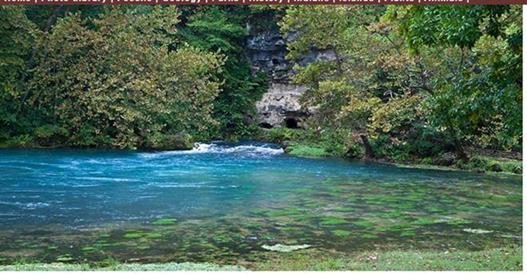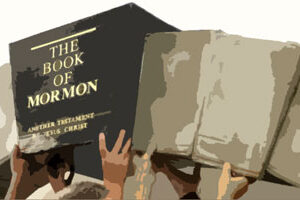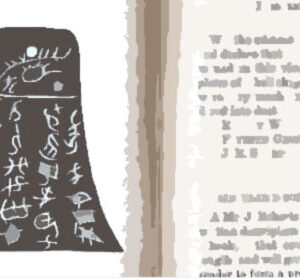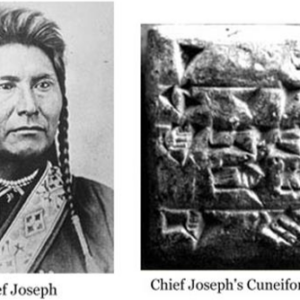Final Thoughts
I have spent the last two years gathering evidence for this document. It has been frustrating and exhilarating all at the same time. There are people I need to thank, including Wayne May and Rod Meldrum. I also thank Wes Trexler for helping review and edit this material.
Some of the sources that I found were through critics. They found helpful information during their attempts to disprove the Book of Mormon and to find sources of how Joseph Smith, Sydney Rigdon and Oliver Cowardly fabricated the Book of Mormon. While disproving the Mesoamerican model they were also providing evidence for the North American model. Discounting the artifacts, language, and cultural similarities to the Hebrews will be harder in North America than the Mesoamerican model. Unless I’m missing something important, critics will have to say Joseph Smith could not have not done it by himself; Joseph Smith, Oliver Cowdery, Sydney Rigdon, and Martin Harris all helped. They will have to say that they were expert archeologist on the Hopewell and Adena cultures. They knew they had metallurgy and woven cloth and breast plates etc. They had an intuitive knowledge of the Hopewell timeline and geography. They were also experts on Native American culture, their language, and beliefs from the Gulf of Mexico and to the Great Lakes. They were experts on old world civilizations especially the Assyrian culture, their artifacts, and writing system and the 12 tribes of Israel as well as the Old testament. But most importantly they also had innate knowledge of DNA and its distribution. Somehow they knew the Druze of Israel and the Great Lake Indians shared the same DNA. If my geography model can be shown to be consistent throughout the Book of Mormon, they also would have known that what sounds like four seas is actually six and the narrow neck and narrow passage are two features not one, but they congruently decided not to tell anybody these crucial bits of information.
Cherry Picking Data
One will notice that the dates given pre-4000BC match up with Book of Mormon. The Problem lies with dates beyond 4000BC. The dates that deal with DNA, North American land mammals and the populating of North and South America don’t line up. How is it that I use dates that are in line with Book of Mormon and dates that are not in line with the Book of Mormon are ignored? The best answer for believers is that I do not believe that human life as we know it existed beyond 4000BC years. Although I do believe that the earth is billions of years old, I believe that human life began with Adam and Eve and not evolution. So dating past 4000BC is irrelevant. This is not a scientific research paper done by a professional that I’m sure everyone has noticed. I have faith that radio carbon dating past 4000BC years is wrong — how I’m going to prove that someday I don’t know but at this point it does not matter.
Data Sources
http://www.eupedia.com/europe/Haplogroup_X_mtDNA.shtml
The Presence of Mitochondrial haplogroup X in Altaians from South Siberia
Am. J. Hum. Genet. 69:237–241, 2001
MtDNA haplogroup X: An Ancient Link between Europe/Western Asia and North America
Michael D. Brown,1 Seyed H. Hosseini,1 Antonio Torroni,2 Hans-Ju¨rgenBandelt,3 Jon C. Allen,1 Theodore G. Schurr,1 Rosaria Scozzari,2 Fulvio Cruciani,2 and Douglas C. Wallace1
http://pidba.org/content/fluted.JPG
https://en.m.wikipedia.org/wiki/Clovis_spear_points
“Great Surprise”—Native Americans Have West Eurasian Origins
Origin and Diffusion of mtDNA haplogroup X
http://www.ncbi.nlm.nih.gov/pmc/articles/PMC1180497/
http://www.academicroom.com/article/identification-horse-exploitation-clovis-hunters-based-protein-analysis
The Dover Mound by William S Webb and Charles Snow
(In Mohawk Country: Early Narratives about a Native People
By Dean R. Snow, Charles T. Gehring, William A. Starna)
https://en.wikipedia.org/wiki/Great_Hopewell_Road
http://www.ncbi.nlm.nih.gov/pmc/articles/PMC1712541/pdf/ajhg00001-0268.pdf
The Adena People
By William S. Webb, Charles E. Snow, James B. Griffin
The Scioto Hopewell and Their Neighbors: Bioarchaeological Documentation and Cultural Understanding
By Daniel Troy Case, Christopher Carr
https://en.wikipedia.org/wiki/Adena_culture
Mounds for the Dead, by Don Dragoo
http://www.ncbi.nlm.nih.gov/pmc/articles/PMC379119/
First Americans arrived as 2 separate migrations, according to new genetic evidence
http://www.sciencedaily.com/releases/2009/01/090108121618.htm
Twelve Millennia: Archaeology of the Upper Mississippi River Valley
By James L Theler and Robert F Boszhardt
https://en.m.wikipedia.org/wiki/Horned_Serpent
A Most Indispensable Art: Native Fiber Industries from Eastern North America
By James B. Petersen
Writings of Caleb Atwater
https://archive.org/details/writingsofcaleba00atwa
New Relations of Gaspesia by Father Chretian Le Clercq
https://archive.org/details/newrelationofgas05lecl
Views of Louisiana by Henry M. Brackenridge
https://archive.org/details/viewsoflouisiana00inbrac
The Natural and Aboriginal History of Tennessee by John Haywood
https://archive.org/details/naturalaborigina00hayw
Ancient History of the six Nations by David Cusick
https://archive.org/details/davidcusickssket00cusi
A Star in the West by Elias Boudinot
https://archive.org/details/starinwestorhumb00boudarch
Myths of the Cherokees by James Mooney
https://archive.org/details/cu31924104080076
New Views of the Origins of the Tribe and Nations of America by Benjamin Barton
https://archive.org/details/cihm_42881
Life of Joseph Brant-Thayendanegea: by William Stone
https://archive.org/details/lifejosephbrant03stongoog
On the Aborigines of the Western Countries by M.H. Frost
https://books.google.com/books?id=HlEoAAAAYAAJ&pg=PA237&lpg=PA237&dq=Colonel+Joseph+Daviess,+when+at+St.+Louis+in+1800,&source=bl&ots=1‑KX4HYPRl&sig=iElRCy9Yhq90k9Xp5dxQYcnUHag&hl=en&sa=X&ei=Q1LzVIzfFaz7sAT0j4GADw&ved=0CB8Q6AEwAA#v=onepage&q=Colonel%20Josephe h%20Daviess%2C%20when%20at%20St.%20Louis%20in%201800%2C&f=false
The History of the American Indians; by James Adair https://books.google.com/books?id=g7BIfx47bLYC&pg=PA209&lpg=PA209&dq=Tuccabatchey-square,+27th+July,+1759,+per+Will,+Bolsover.&source=bl&ots=nRatig0Y0i&sig=sseXSfllLloQxSGHLIinwf0D2_8&hl=en&sa=X&ei=El3zVIHXLrWBsQS0m4KIDQ&ved=0CCEQ6AEwAA#v=onepage&q=Tuccabatchey-square%2C%2027th%20July%2C%201759%2C%20per%20Will%2C%20Bolsover.&f=false
Legends of the Micmac by Silas T Rand
https://archive.org/stream/cihm_12305#page/n13/mode/2up
The Coronado expedition
Voyage to Carolina by John Lawson
http://docsouth.unc.edu/nc/lawson/lawson.html
Problems of the Ohio Mounds by Cyrus Thomas
https://archive.org/details/problemofohiomou00thom
The Hopewell Mound Group of Ohio< Volume 6, Issue 5 by Warren King Moorehead
History, manners, and customs of the Indian nations who once inhabited Pennsylvania and the neighboring states By John Heckewelder
https://archive.org/details/histmannerscust00heckrich
The Tennessee Mound Builders by Joseph Jones
http://www.jstor.org/stable/2447098
Foot-prints of vanished races in the Mississippi valley by Alban Conant
https://archive.org/details/footprintsofvani00conauoft
HISTORY OF THE OJIBWAYS, BASED UPON TRADITIONS AND ORAL STATEMENTS by Warren Williams
https://archive.org/details/historyojibways00nielgoog
The Iowa by William Harvey Miner
http://www.gutenberg.org/wp-content/uploads/39952/39952‑h/39952‑h.htm
Aboriginal monuments of the state of New-York. Comprising the results of original surveys and explorations by E.G. Squier
https://archive.org/details/cu31924104075308
The Mound Builders Their Work and Relics by Rev Stephen D Peet PhD
https://archive.org/details/moundbuilders00peetrich
Link is for Greek language Book of Mormon ties
http://packham.n4m.org/linguist.htm
http://www.phoenixmasonry.org/native_american_rituals.htm




I see you have found a spot for Adam & Eve, now it’s time to figure out how the Elohim made them, it’s in the Sumerian Tablets. All of it and it connects the Hebrews coming here, their large height and the love of the Pipe.
Here are a few things about the Hopewell that must be considered when trying to claim they were the people of the Book of Mormon. A quick overview is that the Hopewell did not grow corn, it came after. They did not grow wheat either. They grew crops that were domesticated in the Eastern U.S., independent of the plant domestications in Meso-America and South America. Their plants were already domesticated before the time of Lehi’s alleged arrival. See “Eastern North America as an independent center of plant domestication”. http://www.pnas.org/content/103/33/12223.full.pdf DNA studies tie the Hopewell to living people, most closely to the Eastern Sioux, Cheyenne, and Arapaho. Makes a person wonder why the temple dedication for the Bismark North Dakota temple never mentioned Lamanites or descendants from Father Lehi. See “New Study of Ancient DNA Reveals Population History of Northeastern North America” http://ohiohistory.wordpress.com/2008/09/04/new-study-of-ancient-dna-reveals-population-history-of-northeastern-north-america/ The study mentioned above is titled “Using Ancient mtDNA to reconstruct the population history of northeastern North America” http://onlinelibrary.wiley.com/doi/10.1002/ajpa.20835/abstract;jsessionid=C9482C29BB23B714A5744A07CF62D33B.f03t04 “One conclusion you might draw from these data is that whatever brought about the end of the Hopewell culture, it did not involve the movement of new groups of people into the Northeast.” That makes it pretty clear that invading armies of Lamanites, mixed with “other” non-BofM people with a different DNA haplotype, simply did not happen. A very informative and interesting study is this doctoral dissertation from Ohio State University “Mitochondrial DNA Analysis of the Ohio Hopewell of the Hopewell Mound Group” https://etd.ohiolink.edu/!etd.send_file?accession=osu1054605467&disposition=inline Pay attention to the Hopewell subsistence… Read more »
Tapir I need to thank you for this last comment. I learned some more stuff about the Hopewell. One is that the Hopewell did grow maize (corn). https://www.britannica.com/topic/Hopewell-culture https://en.wikipedia.org/wiki/Eastern_Agricultural_Complex One very interesting aspect to the Hopewell growing corn is when it started and where its believed it came from. Its believed that the eastern united states agricultural complex started growing corn around 200BC.The mention of corn in the Book of Mormon first appears at 121BC. Give or take a hundred years and the Book of Mormon is right on. Joseph Smith very easily could have mentioned corn at the very beginning around 500BC but that would have been problematic now it’s not. Another point I want to make is that the corn was brought from Mexico. Another example of how extensive Hopewell trade was. It helps confirm that Hopewell trade extended into Mexico along with the Jaguar teeth found at a Hopewell site in Indiana. Your link to the dna study brought up some interesting points. One of the closest match to the Hopewell dna were the Mississippian culture. That was not surprising to me at all since the Mississippian have depictions of flying snakes on their pottery. It matches quite nicely with Nephi teaching about the fiery flying serpents mentioned in the bible. It also helps that native American believed in a fiery serpent described “Those who know say the Uktena is a great snake… and a bright blazing crest like a diamond on its forehead, and scales glowing… Read more »
See pages 7 and 8 of Dr. Mill’s dissertation concerning maize. The studies are explained and sourced and the conclusions are sound. The statement “Overall, maize does not seem to be a major component in the diet of any Ohio Valley population, including the Ohio Hopewell, prior to 1000 B.P.” is far more accurate and reliable than Wikipedia or Brittanica.
https://etd.ohiolink.edu/!etd.send_file?accession=osu1054605467&disposition=inline
“I’m not sure why you brought up the bureau of ethnology book. Many of the people who contributed to this book I quote extensively throughout my research.”
If you are not sure, then read it and study it beginning on page 595. Your conclusions and far too many of your ideas are simply flawed and wrong. I suggest you approach your study of the Hopewell without pre-conceived notions or bias caused by the Book of Mormon.
https://archive.org/stream/bureauofethnology00thomrich#page/594/mode/2up
“I already had accounts of elephant smoke pipes” David, those effigy elephant pipes you have used in your writing are verified known hoaxes, even better documented hoaxes than the Michigan Relics.. A little more research on your part would have uncovered that.
Read the conclusion about elephants on page 642. It is sound, credible and reliable. Your elephant evidences are frauds.
https://archive.org/stream/bureauofethnology00thomrich#page/642/mode/2up
“The book also states that the native Americans believed in a messiah religion.”
David, you MUST re-read that page.
https://archive.org/stream/bureauofethnology00thomrich#page/n35/mode/2up
It had absolutely nothing to do with the Hopewell.It was the Ghost Dance which culminated with the massacre at Wounded Knee on December 29, 1890.
Yeah , I will have to agree on the Wisconsin horse. A blog is not good documentaion to confirm or deny. I have to disagree with the Newark holy stones. How can this be confirmed? Where is the evidence? Opinions can only be considered as hearsay and not fact. If you have proof that Wyric hoxed the stones, I welcome your input. Here is an aticle that list the facts. http://saturniancosmology.org/files/.cdrom/journals/horus/v0203/horus06.htm
Conclusive proof that the Newark Decalogue Stone is a Forgery
http://apps.ohiohistory.org/ohioarchaeology/conclusive-proof-that-the-newark-decalogue-stone-is-a-forgery-and-not-a-very-good-one-at-that/
http://apps.ohiohistory.org/ohioarchaeology/a‑likely-source-for-the-design-of-the-newark-decalouge-stone/
NEWARK HOLY STONE IS FEATURED ON AMERICA UNEARTHED
http://apps.ohiohistory.org/ohioarchaeology/newark-holy-stone-is-featured-on-america-unearthed/
here is the link: http://www.s8int.com/truesuppressions3.html scroll down to don’t need to carbon date the farmer horse.
Thanks Dave. It is not the Spencer Lake horse skull, so that is now clarified. It appears those bones in your link were finally radiocarbon dated.
See this link.
http://www.ancientlosttreasures.com/forum/viewtopic.php?f=50&t=1201
Post Number:#3 Postby WonHooSeeks » Mon Jul 04, 2011 3:02 pm
After contacting the UWMilw. person that has oversight of these horse bones, I received this reply, listed below in it’s entirety. Won
Tue 22/08/2006
1) There was indeed a horse found in a burial mound excavated by WC McKern in the early part of the 20th century. Horse and cow bones are very common discoveries at archaeological sites located on modern farms, and their presence by themselves isn’t important. What is important is the stratigraphic context of the bones.
2) McKern (a major figure in midwestern archaeology) considered the horse to be a modern burial (i.e., a post-european deposition), based on the archaeological deposits. The stratigraphy showed that the horse had been buried long after the mound had been built.
3) I do not know anything about the reported conversations or quotes, and I don’t know the time frame of the rest of the story on your web page. True or not, those conversations, etc. have been superseded by more recent events.
4) An accelerator mass spectrometry date was obtained from the bones of the horse a couple of years ago. The radiocarbon dating corroborates McKern’s archaeological assessment. It is a modern, post-AD 1800 horse that had been buried in the mound.
I hope this helps.
RJJ
After studying this a little more, I have changed my mind. It appears to be the Spencer Lake hoax skull, as that was found by McKern as mentioned in the 2006 reply reported by Won.
The link you gave contains many questionable claims such as the Newark Stones (a confirmed hoax), and I’m suspicious that the claim of the horse was found in 1985, rather I suspect it is really about the earlier Spencer Lake skull. One of the problems with sources like that link is that it doesn’t give references that can be checked. It is just statements and claims with no way to verify. Until better sources are provided, I’m going to consider it the Spencer Lake skull.
https://archyfantasies.com/2013/07/31/where-the-vikings-werent-wisconsin-viking-horse-skull/
Dave The other article you posted is quite interesting it states that they have dated horse bones to before European arrival. “Another Equus specimen was identified by Elaine Anderson, an expert on Equus identification, at Wolf Spider cave, Colorado. It dated to AD 1260 – 1400, again clearly before Columbus” It has become quite clear to me as you have also stated that the Hopewell Indians were a advance civilization that matches the Nephite civilization stated in the Book of Mormon. They were metal breast plates and head plates. They made their clothe and clothing. They made metal tools, weapons, and jewellery. Their dna is also located in Israel. I could continue to go on. If you want to read another interesting article there is one about a forged iron ax found at a Iroquois arch site in 2012 that dates before European arrival. In my opinion archaeologist wrongly attribute the metal work to European manufacture instead of Native American manufacture. European archaeologist and researchers have a history of doing this both in the 19th century and 20th century. http://indiancountrytodaymedianetwork.com/2012/07/09/how-did-spanish-axe-wind-toronto-100-years-europeans-122571 “Arlington Mallery excavated a long tube of iron slag from an Adena site in the Ohio Valley.” “(An iron sword was found in a North Carolina mound. Due to this item Cryus Thomas who believed that the mounds were built after the Europeans arrived. We know the Hopewell mounds were built before Columbus) The iron implements which are alluded to in the above-mentioned articles also in Science, as found in a… Read more »
Dave, I didn’t post the link to the article that you just quoted “Another Equus specimen was identified by Elaine Anderson, an expert on Equus identification, at Wolf Spider cave, Colorado. It dated to AD 1260 – 1400, again clearly before Columbus”. You posted the link to that article earlier. Here is what you had posted to me:
Dave · March 14, 2016 at 11:58 am
I thought they did publish the horse dates but could be a different case. Look at the horse conspiracy site: http://thewildhorseconspiracy.org/2013/07/02/exciting-article-about-by-phd-steven-jones-re-more-recent-surviving-native-horse-in-north-america/ Horses dated before Columbus and after 11,000 BC.
You are quoting from your own link but claiming I posted it, which is simply not true.
I thought they did publish the horse dates but could be a different case. Look at the horse conspiracy site: http://thewildhorseconspiracy.org/2013/07/02/exciting-article-about-by-phd-steven-jones-re-more-recent-surviving-native-horse-in-north-america/ Horses dated before Columbus and after 11,000 BC. The point is this is a good discussion that shouldn’t be ignored by most academia. So is it possible the Chinese explorers brought them, yes. Is it possible that the Viking brought the horse to America, yes. And is it possible they never went extinct, Yes. The problem I have with the status quo is they are close minded to any other possibility and can’t understand that theories are not fact until enough evidence is collect. I don’t think you can call something as fact when you contradicting evidence. I have seen very little scientific evidence to suggest the horses when extinct and find more evidence suggesting the contrary.
Dave, I must ask again. Could you please tell me the article that you read about the Wisconsin archaeologist who found the Indian pony in a burial mound? Where was it found? Let’s get your source and make sure it isn’t the same one that has been repeated but is bogus.
I have read that salt water can leache the carbon-14 from archeological Objects making them appear older. Thus if the flood did happen covering the whole earth it is possible that the flood is the cause for some objects or humans bones having dates older than 4000BC. I find the previous post challenge humorous to accept archeological evidence as absolute. When in fact there is little evidence to support such theories as the beringia theory as fact. In fact I wouldn’t call most these scientists who support this thought as theorists because the theory is more important than the evidence. For example I read in article the other day how Wisconsin archeologist found an Indian pony in a Native American burial mound and assumed without any evidence that a farmer buried the horse in the mound because every body knows no horses before Columbus. The “no horses before Columbus” is not a fact but an opinion turned to fact by the education system. So how can we call this archeologists a scientist when he employs no scientific work to discover if the horse buried in the mound has dates with in the time of the hopewell. This is only one example out of many object in North America that have been ignored because they don’t fit the theories. So I’m not interested in the theorists opinion, I can think for myself.
Dave, the carbon-14 claims you make do not hold up to serious study. You can easily research the facts if you do so without bias. But what concerns me most right now is your statement about the Wisconsin horse skull hoax. Please don’t continue to repeat that one, too many LDS members have fallen for it and it needs to stop. Here are some facts with sources, please consider them and stop the spread of bogus claims. In 1935 a horse skull was found in a Wisconsin mound. In 1936 a college student found out about the skull. He confessed that when he was in his teens he and a friend had buried that skull in the mound. Like teens today, they laughed what someone would think if they found it two hundred years later but as an adult he wanted to make things right. The confession did not get reported right away. In 1962 the former student was now a professor and he wrote a statement of his teen mischief. Another professor identified the skull as a western mustang and noted that rodents had gnawed it, meaning it had been above ground for some time before it was buried in the mound. This backed up the confession. The Spencer Lake horse hoax was finally exposed in 1964 in the Wisconsin Archaeologist. http://www.archive.org/stream/wisconsinarcheol44wiscrich#page/n367/mode/2up In 1967 radiocarbon dating results were published for the mound, showing it to be in the period from 500 to 1000 AD. There are people who need more… Read more »
I have not heard of the Wisconsin horse skull story. What I used as evidences for horses mentioned in the Book of Mormon is as follows. For example Hopewell Indians trade who I believe are the Nephites have trade routes that extended over a thousand miles from which they brought commodities from the Rocky Mountains and possibly Central America. I don’t believe they walked thousands of miles carrying their supplies and commodities on their backs. I believe they used horses and chariots. The second point is this, a species of precolumbian horse went extinct in North America. Some anthropologist believe this species of horse went extinct due to human predation because horse protein has been found on ancient stone arrowheads. I agree that horses went extinct due to human predation. What I disagree with is when the last horse was killed. I believe the Nephites or the lamanites caused the extinction of this species of horse found in North America. See section about horses.
Dave, you had said “For example I read in article the other day how Wisconsin archeologist found an Indian pony in a Native American burial mound and assumed without any evidence that a farmer buried the horse in the mound because every body knows no horses before Columbus.”
Now you say “I have not heard of the Wisconsin horse skull story.”
Could you please tell me the article that you read? Who was the Wisconsin archaeologist who found the Indian pony in a burial mound? Where was it found? Let’s get your source and make sure it isn’t the same one that has been repeated but is bogus.
I was impressed by the effort put into this until I got to the conclusion.
“I do not believe that human life as we know it existed beyond 4000BC years.”
That is a rather big pre-condition to put on any genuine open-minded research.
David, you have faith that radio carbon dating past 4000BC years is wrong. This single statement in your conclusion sets the stage for how difficult It will be to disprove all of your claims to you, in a manner that will meet your satisfaction. On the other hand, all of your claims have been disproved to the satisfaction of scientists, archaeologists, historians, etc. Are you prepared to accept actual evidence without bias? Because if not, there is no point trying to disprove anything further to you. But if you are interested in truth no matter what the outcome might be and no matter what you have faith in right now, if you are willing to discard your faith if it is proven wrong, I can help steer you to many credible sources concerning your claims. Are you willing to face that challenge? If not, let’s wait until you are.